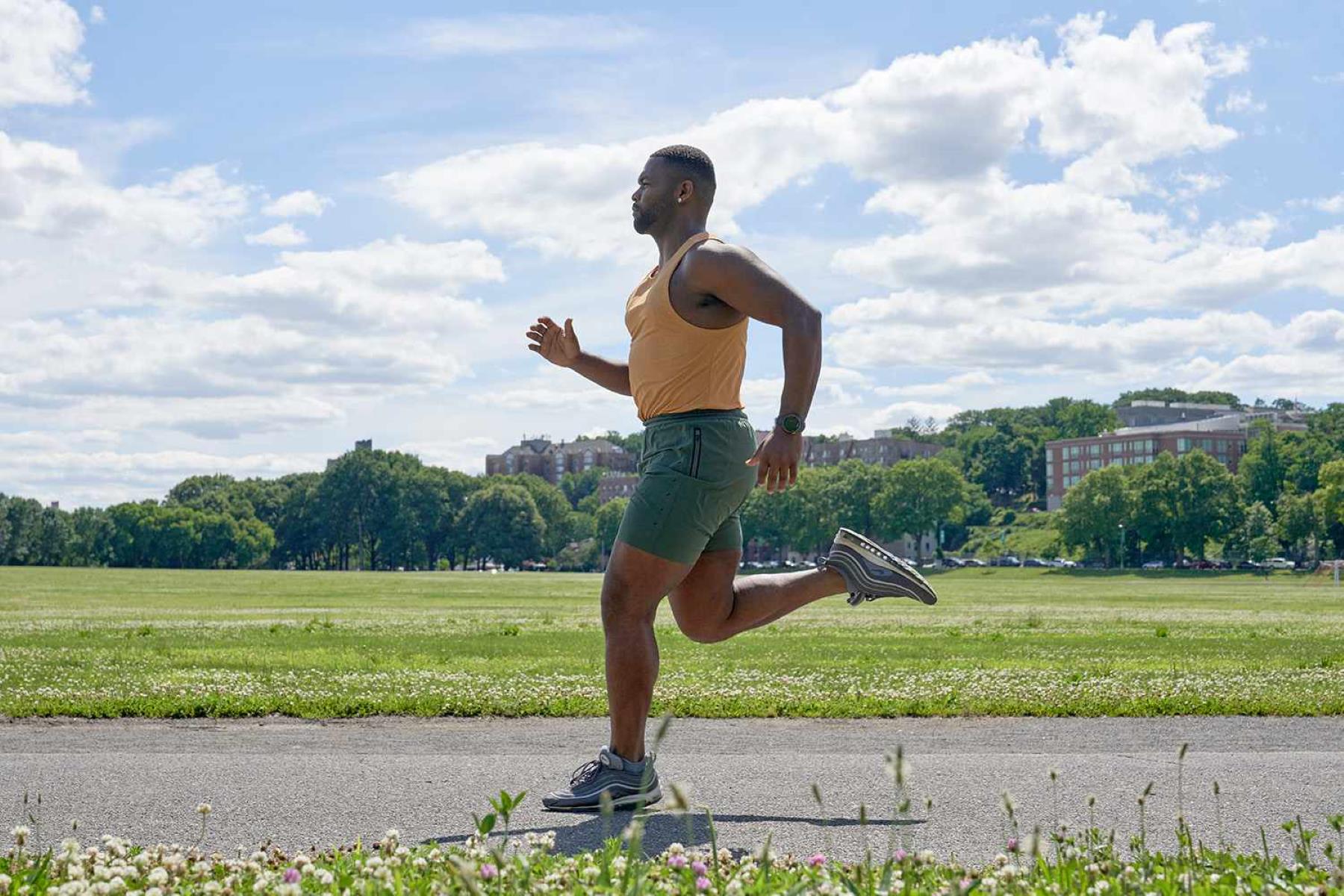

Featured
What Is A Sprint In Running
Modified: January 2, 2024
Learn about the featured sprint in running, its benefits, and how to incorporate it into your training routine to improve speed and performance.
Introduction
Welcome to the world of sprinting, a thrilling and dynamic form of running that combines speed, power, and technique. Whether you are a competitive athlete, an aspiring sprinter, or simply looking to improve your fitness level, understanding the fundamentals of sprinting is essential.
Sprinting is a high-intensity running activity that involves giving maximum effort over a short distance. It is a discipline that has captivated both athletes and spectators for centuries, from the ancient Olympic Games to the modern-day track and field events.
The essence of sprinting lies in its explosive nature, as sprinters strive to reach the finish line in the shortest possible time. This explosive power is not only thrilling to watch, but it also holds immense benefits for the athletes themselves.
In this article, we will delve into the world of sprinting, exploring its definition, highlighting the various benefits it offers, discussing different training techniques, and providing important considerations for sprinters. Additionally, we will touch upon common injuries associated with sprinting and offer prevention strategies to keep you in top form.
Whether you are a seasoned sprinter or just beginning your sprinting journey, this article will equip you with the knowledge and insights necessary to excel in this exhilarating sport.
Definition of Sprint
A sprint can be defined as a short and explosive burst of running, typically covering distances ranging from 60 meters to 400 meters. Unlike long-distance running, where endurance plays a key role, sprinting focuses on speed, power, and acceleration.
Sprinting requires athletes to generate a tremendous amount of force in a short period, propelling their bodies forward with maximum speed and efficiency. It involves a rapid contraction of muscles, predominantly in the lower body, including the legs, glutes, and core.
One of the distinguishing features of a sprint is the short duration involved. Unlike long-distance running, where athletes focus on pacing themselves over extended periods, sprinters aim to cover the given distance as quickly as possible.
The explosive nature of sprinting relies on the body’s anaerobic system, which provides energy for quick bursts of intense activity without requiring oxygen. This contrasts with aerobic endurance activities like long-distance running, which rely primarily on the body’s aerobic system that utilizes oxygen for fuel.
Sprinting is not just restricted to track and field events; it is also a fundamental component of various sports, including football, basketball, soccer, and many others. The ability to sprint quickly and efficiently is often a crucial aspect of athletic performance, enabling athletes to outrun opponents, make fast breaks, or reach the finish line ahead of the competition.
For those seeking to improve their overall fitness and conditioning, incorporating sprint workouts into their routine can provide a challenging and effective training method. Sprinting engages multiple muscle groups, builds explosive power, and elevates the heart rate, leading to improved cardiovascular fitness and increased calorie burn.
Now that we have a clear understanding of what a sprint is, let’s dive into the numerous benefits that sprinting offers.
Benefits of Sprinting
Sprinting offers a wide range of benefits that go beyond simply improving speed. Let’s explore some of the key advantages of incorporating sprinting into your fitness routine:
- 1. Enhanced Speed and Power: Sprinting helps to develop explosive power in the muscles, leading to significant improvements in speed and acceleration. By repeatedly engaging in high-intensity sprints, athletes can train their bodies to generate greater force with each stride.
- 2. Increased Cardiovascular Fitness: Sprinting is an excellent aerobic exercise that challenges the cardiovascular system. Regular sprinting sessions can strengthen the heart and lungs, improve oxygen utilization, and enhance overall cardiovascular endurance.
- 3. Efficient Calorie Burning: Sprinting is a highly effective calorie-burning activity. The intense effort required during sprints elevates the heart rate and engages multiple muscle groups, resulting in a high metabolic rate that continues even after the workout is over.
- 4. Muscle Development: Sprinting targets multiple muscle groups, including the quadriceps, hamstrings, glutes, and calves. By consistently engaging these muscles, sprinting can help to build lean muscle mass and improve overall muscle tone and definition.
- 5. Improved Athletic Performance: Since sprinting involves explosive movements and quick bursts of speed, it can greatly enhance athletic performance in other sports. The improved speed, power, and agility gained from sprinting can give athletes a competitive edge in activities such as basketball, soccer, tennis, and more.
- 6. Increased Bone Density: Sprinting is a weight-bearing exercise that puts stress on the bones, which in turn stimulates bone density and strength. Regular sprinting can help reduce the risk of osteoporosis and improve overall bone health.
- 7. Mental Benefits: Sprinting not only improves physical fitness but also has positive effects on mental well-being. The release of endorphins during sprinting can boost mood, reduce stress levels, and improve overall mental clarity and focus.
These are just a few of the many benefits that sprinting can provide. Whether you are an athlete looking to enhance your performance or someone simply aiming to improve their fitness level, sprinting can be a valuable addition to your exercise routine.
Sprint Training Techniques
Effective sprint training involves a combination of specific exercises, proper form, and structured workout plans. Here are some key training techniques to help you maximize your sprinting potential:
- 1. Warm-up and Stretching: Prior to any sprinting session, it is important to warm up the body and stretch the major muscle groups involved. This helps to increase blood flow, flexibility, and reduce the risk of injury.
- 2. Interval Training: Interval training involves alternating between high-intensity sprints and periods of active recovery. This technique allows for more intense effort during the sprints while still providing some rest time to recover. For example, you could sprint at maximum effort for 30 seconds, followed by a 1-minute recovery jog, and then repeat the cycle several times.
- 3. Fartlek Training: Fartlek, meaning “speed play” in Swedish, is a training method that combines continuous running with intermittent sprints. This technique allows for a more varied and spontaneous workout by incorporating periods of increased intensity throughout a longer run.
- 4. Hill Sprints: Incorporating hill sprints into your training routine can greatly improve leg strength and power. Find a steep hill and sprint up at maximum effort, then walk or jog back down for recovery. Repeat the cycle for several rounds, gradually increasing the number of repetitions as your fitness level improves.
- 5. Plyometric Exercises: Plyometric exercises, such as box jumps, skipping, and explosive lunges, can enhance the power and explosiveness required for sprinting. These exercises involve rapid muscle contractions and dynamic movements that target the same muscles used during sprints.
- 6. Technique Work: Focus on proper sprinting technique to maximize efficiency and speed. This includes maintaining an upright posture, driving the knees and arms forward, pushing off the balls of the feet, and maintaining a quick and powerful stride.
- 7. Rest and Recovery: Adequate rest and recovery are crucial for improvement and injury prevention. Allow for rest days between sprint sessions to give your muscles time to repair and rebuild. Also, prioritize quality sleep and incorporate stretching and mobility exercises to enhance recovery.
Remember, consistency and gradually increasing the intensity and duration of your sprints over time are key to improving your sprinting abilities. Always listen to your body and consult with a coach or trainer for personalized guidance and advice.
Different Types of Sprints
Sprinting encompasses a variety of distances and techniques. Let’s explore some of the different types of sprints that are commonly practiced:
- 1. 100-Meter Sprint: The 100-meter sprint is one of the most iconic and exciting events in track and field. It requires explosive speed and power, with athletes aiming to cover the distance in the shortest possible time. It is often considered the epitome of pure sprinting.
- 2. 200-Meter Sprint: The 200-meter sprint is a slightly longer sprint that requires a combination of speed and endurance. Athletes must maintain their speed over a longer distance, making it a test of both raw power and stamina.
- 3. 400-Meter Sprint: The 400-meter sprint is a demanding event that combines speed and endurance. It requires athletes to maintain a high level of intensity and effort for a full lap around the track.
- 4. 4×100-Meter Relay: The 4×100-meter relay is a team event where each participant sprints 100 meters before passing the baton to the next runner. It showcases teamwork, coordination, and speed, making it one of the most exciting relay races to watch.
- 5. 4×400-Meter Relay: The 4×400-meter relay is another team event where each runner covers 400 meters before passing the baton. It requires a combination of speed, endurance, and strategic pacing, as each member of the team aims to maintain the pace and hand off the baton smoothly.
- 6. Hurdle Sprints: Hurdle sprints combine sprinting with the added challenge of jumping over hurdles at specific distances. Events like the 110-meter hurdles (for men) and the 100-meter hurdles (for women) require athletes to maintain their speed while efficiently clearing hurdles placed at regular intervals.
- 7. Steeplechase: The steeplechase is a long-distance event that incorporates several barriers and a water jump. Athletes must combine speed, endurance, and technique to navigate the track while jumping over hurdles and tackling the water jump.
Each type of sprinting event has its own unique demands and requires specific training techniques to excel. Whether you prefer the explosive speed of the short sprints or the endurance challenge of the longer distances, there is a sprinting discipline to suit your preferences and goals.
Important Considerations for Sprinters
While sprinting can be an exhilarating and rewarding activity, it is essential to keep in mind some important considerations to ensure safety, progress, and long-term success. Here are a few key factors to consider as a sprinter:
- 1. Proper Technique: Developing and maintaining proper sprinting technique is crucial to maximize efficiency and reduce the risk of injury. Focus on maintaining proper posture, arm and leg mechanics, and foot strike to optimize your performance.
- 2. Gradual Progression: As with any physical activity, it is important to progress gradually to prevent overexertion and strain. Start with shorter distances and lower intensities, gradually building up to longer sprints and higher speeds over time.
- 3. Strength and Conditioning: Incorporating strength and conditioning exercises into your training routine is essential to support sprinting performance and reduce the risk of injury. Focus on exercises that target the major muscle groups used in sprinting, such as squats, lunges, plyometrics, and core exercises.
- 4. Recovery and Rest: Allow for adequate rest and recovery between sprint sessions to allow your muscles to repair and rebuild. This includes prioritizing quality sleep, incorporating active recovery days, and listening to your body’s signals of fatigue or pain.
- 5. Injury Prevention: Pay attention to your body and address any signs of pain or discomfort promptly. Incorporate a well-rounded warm-up and cool-down routine, stretching exercises, and mobility work to maintain flexibility and prevent common sprinting injuries, such as muscle strains or tendonitis.
- 6. Proper Nutrition and Hydration: Fuel your body with a balanced diet that includes a mix of macronutrients (carbohydrates, proteins, and fats) to support energy production and muscle recovery. Stay properly hydrated before, during, and after training sessions to maintain optimal performance.
- 7. Coaching and Guidance: Consider seeking guidance from a qualified sprinting coach who can provide personalized advice and training programs based on your goals and abilities. A coach can help monitor your progress, correct technique, and provide valuable insights to enhance your sprinting performance.
By considering these important factors, you can improve your sprinting performance, reduce the risk of injury, and ensure long-term success in this exciting and dynamic discipline.
Common Injuries and Prevention
While sprinting offers numerous benefits, it also carries the potential risk of injuries. Understanding common sprinting injuries and taking preventive measures can help minimize the likelihood of setbacks. Here are some common sprinting injuries and tips for their prevention:
- 1. Strains and Sprains: Muscle strains and ligament sprains are common injuries in sprinting. To prevent these, ensure proper warm-up before each session and gradually increase the intensity of your sprints. Incorporate strength training exercises that target the muscles used in sprinting to improve their resilience and flexibility.
- 2. Tendonitis: Tendonitis, characterized by inflammation of tendons, can occur in areas such as the Achilles tendon or patellar tendon. Engage in proper warm-up and cool-down routines, stretch the calves and quadriceps, and use proper footwear with appropriate support to prevent excessive strain on the tendons.
- 3. Shin Splints: Shin splints are painful sensations along the shin bone caused by inflammation of the muscles, tendons, and bone tissue. Gradually increase the intensity and duration of your sprints, incorporate rest days, and use proper footwear to reduce the risk of shin splints. Strengthening the muscles of the lower leg through exercises like toe raises can also help prevent this condition.
- 4. Hamstring Injuries: Hamstring strains and pulls are common among sprinters. To prevent hamstring injuries, regularly perform exercises that target hamstring strength and flexibility, such as hamstring curls and dynamic stretching. Avoid overstriding during sprints and ensure proper warm-up to optimize muscle activation and reduce the risk of strains.
- 5. Achilles Tendon Injuries: Achilles tendon injuries can occur due to overuse or sudden bursts of activity. Incorporate exercises that strengthen the calf muscles, such as calf raises and eccentric heel drops. Gradually increase the intensity of your sprints and avoid sudden increases in mileage or intensity to protect the Achilles tendon.
- 6. Dehydration and Heat-related Illness: Sprinting is an intense activity that can lead to dehydration and heat-related illnesses. Stay properly hydrated before, during, and after workouts, especially in hot and humid conditions. Drink water and electrolyte-rich fluids, and wear appropriate clothing that allows for proper ventilation to regulate body temperature.
- 7. Overtraining: Overtraining can lead to a variety of injuries and negatively impact performance. Allow for adequate rest and recovery between sprint sessions, incorporate active recovery days, and listen to your body’s signals of fatigue or pain. Follow a well-designed training plan that includes progressive overload and planned rest periods to avoid overtraining.
By understanding these common injuries and taking preventive measures, you can sprint safely and minimize the risk of setbacks. Remember to consult with a healthcare professional if you experience persistent pain or have concerns about a specific injury.
Conclusion
Sprinting is a thrilling and dynamic form of running that offers numerous benefits for athletes of all levels. It combines speed, power, and technique to create an exhilarating experience that pushes the limits of human capabilities. By incorporating sprinting into your fitness routine, you can enhance your speed, power, cardiovascular fitness, and overall athleticism.
Throughout this article, we have explored the definition of sprinting, discussed the benefits it offers, and highlighted important considerations for sprinters. We have also delved into different types of sprints, sprint training techniques, and common injuries and prevention strategies. By understanding these key aspects, you can approach sprinting with knowledge, stamina, and safety.
Whether you aspire to compete in track and field events, improve your athletic performance, or simply challenge yourself in a new fitness endeavor, sprinting is a rewarding discipline to explore. It demands dedication, proper technique, and a progressive approach to training. By incorporating sprinting into your routine and implementing proper warm-ups, strengthening exercises, and injury prevention strategies, you can maximize your sprinting potential while minimizing the risk of setbacks.
Remember to listen to your body, consult with professionals when needed, and gradually progress in your training. Sprinting is not only a physical activity but also a mental and emotional experience. Embrace the thrill of the sprint, push yourself to new limits, and enjoy the sense of accomplishment that comes with reaching your goals.
So lace up your running shoes, find a track or open space, and embark on your sprinting journey. Whether you’re sprinting for competition, personal fitness, or simply the joy of movement, sprinting can be an exhilarating and transformative experience that brings out the best in you.









